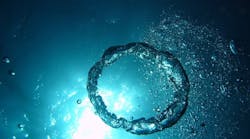What is a dissolved air flotation system?
Dissolved air flotation (often abbreviated DAF) is water treatment process in which suspended solids, metals, and also particulate matter are removed to clarify the wastewater. The clarified water, resulting from the DAF treatment, can be reused or discharged to the sewer depending on the type of wastewater treatment.
DAF is used in municipal wastewater treatment, industrial wastewater treatment, and also for drinking water treatment. In these treatment systems, DAF is used to remove a diverse range of pollutants as listed in Table 1. These include suspended solids, organic matter, hydrocarbons from the oil and gas industry, phosphorus and nitrogen from the food and beverage industry, and minerals and metals from the mining industry.
How does a dissolved air flotation system work?
In a DAF system, compressed air is pumped into the flocculation chamber of the wastewater system and the compressed air is released at atmospheric pressure. The released air forms tiny bubbles that adhere to the suspended matter. The air bubble-suspended matter floats to the surface of the water (called the floc) and can be removed by a skimming device.
Coagulant or flocculants are added to allow suspended solids and colloidal solids to clump together for their removal by the DAF system. Polyelectrolyte or polymers could be included in situations of reduced performance of the DAF system if the floc is fragile and cannot be removed entirely by skimming.
Coagulants include alum, poly aluminum chloride, poly aluminum sulfate, ferric chloride, bentonite, and organic polymers. The use of these chemicals depend on what needs to be removed. For example, a study showed that monomeric aluminum was more efficient in removing suspended solids and soluble chemical oxygen demand (COD) than polymeric or colloidal aluminum. However, polymeric or colloidal aluminum were more effective in removing soluble silica.
Dissolved Gas Flotation systems using nitrogen gas
In the oil and gas industry, a modified version of the DAF is used, called the dissolved gas flotation system (DGF) in which nitrogen gas, rather than air (that contains oxygen), to reduce the risk of explosion, is used to create microbubbles. This technology is used to reduce the oil concentration to less than 25 ppmv (parts per million by volume).
In DGF, bubbles are formed by nucleation of gas dissolved in both water and the oil phases in reduced pressure. Nucleation is when atoms or molecule aggregate to form a new phase or structure.
Desalination pretreatment
Besides its use in drinking water treatment, DAF is also used for pretreatment in seawater desalination systems to remove algae. The high amount of algae removed by the DAF process protects the membrane in reverse osmosis (which is used for desalination of seawater) in the desalination plant from fouling.
What is the difference between sedimentation and dissolved air flotation?
DAF removes flocculated particles and suspended solids that float on the surface of the water which can be removed. In contrast, sedimentation removes solids that have settled to the bottom of the water and are removed from the bottom of the water. Depending on the source of the wastewater that is used for the DAF treatment and the chemical content and concentration of the pollutants in the wastewater, DAF treatment can lead to sludge formation. Chemicals, depending on their properties, that do not float due to the DAF treatment, can sink to the bottom and form a sludge that would then need to removed.
What are the advantages and disadvantages of DAF?
Advantages of DAF skew toward improved water quality across a couple of metrics, but it comes at the cost of increased energy due to the use of air compression for treatment.
Advantages:
- Light particles such as algae that are difficult to settle can be removed by DAF.
- DAF treatment can remove light particles of low concentrations unlike sedimentation that requires a higher concentration of particles to settle for their removal. DAF treatment can be operated using much higher surface loading rates (SLR) than sedimentation.
- DAF treatment leads to clarified water by removing pollutants to assist the water in meeting regulatory standards and depending on the wastewater treatment system, for safe discharge of the treated water into the water bodies.
- Chemical oxygen demand (COD) and biological oxygen demand (BOD) removal.
- Helps drinking water achieve clarity and contributes to preventing issues related to taste, odor, and the possible formation of disinfection byproducts during the water treatment.
Disadvantages:
- DAF treatment is not suitable for raw water with high density solids.
- DAF treatment uses more energy than sedimentation processees because it requires air compression that requires energy.
- Floated solids can settle in low water temperature and during rain events.
- DAF requires design implementation for large scale wastewater treatment.
DAF treatment clarifies wastewater and although it uses more energy than for the sedimentation process because energy is needed to compress the air and design implementation is required for wastewater treatment on a large scale, a DAF treatment assists in meeting water regulatory standards.
About the Author
Saleha Kuzniewski
Saleha Kuzniewski, Ph.D. has authored several publications in the fields of scientific research, biotechnology, and environmental regulations. She is the winner of the 2023 Apex award for publication excellence. She is also the founder of Environmental Remediation & Innovations, LLC. Kuzniewski can be reached at [email protected].


